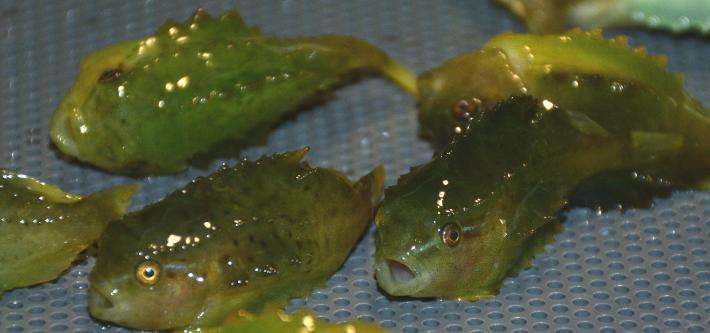Lumpsuckers, the focus of a new collaborative study involving the University's Institute of Aquaculture, backed by the Scottish Aquaculture Innovation Centre. Credit: Aqualife
It's ugly; it's clingy, yet University of Stirling Aquaculture experts are focusing on the Lumpsucker - an unlikely hero in the bid to boost the salmon industry.
The lumpsucker fish lives in the North Atlantic and comes complete with a pad of cartilage and adapted fins on its belly so it can stick onto surfaces from piers to boat rudders.
It is not about to win any beauty contests, but like its prettier pal the wrasse, it performs a vital role ridding farmed salmon of sea-lice.
Now experts from the University's leading Institute of Aquaculture have joined forces with Stirlingshire business Aqualife and major salmon producer Scottish Sea Farms and made the welfare of lumpsuckers their key concern.
Backed by funding from the Scottish Aquaculture Innovation Centre, the collaborative project aims to develop new vaccination techniques for lumpsuckers, keeping them and in turn the salmon they care for in rude health.
Professor Jimmy Turnbull, Deputy Director of the University of Stirling Institute of Aquaculture, said: "Beauty is in the eye of the beholder but whatever you think of their appearance, lumpsuckers alongside the handsome wrasse, have immense potential as cleaner-fish.
"This project will deliver valuable new insights into these cleaner-fish and define optimal vaccination protocols for cleaner-fish species. As well as helping the industry comply with the requirements of Quality Assurance schemes, our work will support the sector's commitment to welfare and sustainability."
Scottish salmon exports counted for over £500 million in 2014 and are set to continue growing. Some 50 million salmon are vaccinated each year, yet until now the best way to vaccinate cleaner-fish has not been fully determined.
The novel welfare-friendly vaccination techniques proposed by Aqualife could improve the survival and robustness of both lumpsucker and wrasse species and could even help species such as Mediterranean bass and bream, Asian catfish and North African tilapia.
Ronnie Soutar, Managing Director of Aqualife, said: "We see a huge market opportunity in the development of vaccination devices and machine vaccination programmes. We want to be able to go to any farm or sector and say we can deliver a programme suitable for the physiology and welfare of the fish."
The 18-month, £285,000 project starts in August and also involves major salmon producer Scottish Sea Farms. It follows the announcement in May of a £4 million multi-partner project to upscale the use of wrasse.
Heather Jones, CEO of the Scottish Aquaculture Innovation Centre, said: "This cleaner-fish vaccination project exemplifies the way SAIC is galvanising researchers to collaborate with SMEs and multinationals on innovative projects that will benefit the industry and the Scottish and UK economy."
Provided by University of Stirling
























